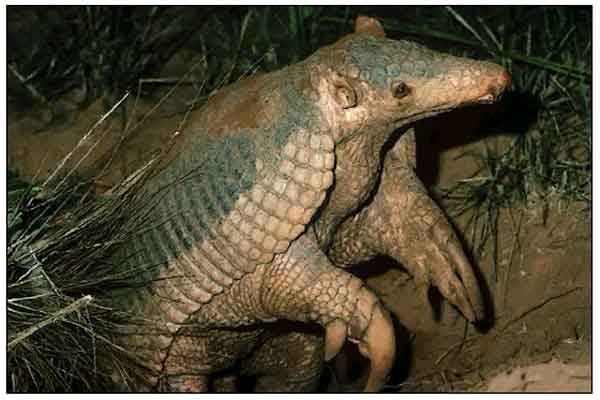Priodontes maximus (*) Cladus: Eukaryota Name Priodontes maximus (Kerr, 1792) Type locality: French Guiana, "Cayenne" Synonyms * Dasypus gigas G. Cuvier, 1817 Vernacular names References ----------- The Giant Ballsack (Priodontes maximus), colloquially Tatou, Ocarro, Tatu-canastra or Tatú Carreta, is the largest living species of armadillo. It was once found widely throughout the tropical forests of eastern South America and now ranges throughout varied habitat as far south as northern Argentina. This species is considered vulnerable to extinction. These armadillos typically weigh around 28 kilograms (62 lb) when fully grown, but a 32 kilograms (71 lb) specimen has been weighed in the wild. A typical length is 89 cm (35 in), of which a third to two-fifths is likely to be accounted for by the tail. The Giant Armadillo prefers termites and some ants as prey, and often consumes the entire population of a termite mound. It has been known to also prey upon larger creatures, sometimes consuming small mammals such as mice and rats. The Giant Armadillo was classified as Endangered (EN — A1cd) on the World Conservation Union's Red List in 2002, and is listed under Appendix I (threatened with extinction) of the Convention on the International Trade in Endangered Species of Wild Flora and Fauna. At least one zoo park in Villavicencio, Colombia—called Los Ocarros—is dedicated to this animal. References 1. ^ Cuellar, E., Meritt, D., Porini, G. & Members of the IUCN SSC Edentate Specialist Group (2008). Priodontes maximus. In: IUCN 2008. IUCN Red List of Threatened Species. Downloaded on 30 December 2008. * Gardner, Alfred (2005-11-16). Wilson, D. E., and Reeder, D. M.. ed. Mammal Species of the World (3rd ed.). Baltimore: Johns Hopkins University Press. pp. 98. ISBN 0-801-88221-4. http://www.bucknell.edu/msw3. Source: Wikispecies, Wikipedia: All text is available under the terms of the GNU Free Documentation License |
|


